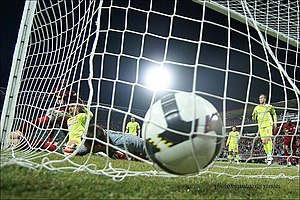- HG – Hard ground is the ideal option for players who play on dry surfaces, or surfaces where grass has been worn away and the ground is barer. This configuration features a low profile with many conical studs to help keep you balanced. Can also be used effectively on FG surfaces.
- SG – Soft Ground boots should only be worn when the surface is soft enough for the studs to penetrate the surface. This is the configuration of choice for players in areas where it rains very frequently and they usually feature replaceable studs.
- AG – Artificial Ground is the newest type of configuration that companies are trying to incorporate into the market. AG is specific to newer turf surfaces and the top brands have proven extremely effective in producing excellent traction. Not to be used on FG.
- FG – Firm Ground boots are best suited to natural grass surfaces where it doesn’t rain regularly. With so many locations taking to artificial grass, companies are adjusting their designs and FG is now pretty much accepted as an option for Artificial pitches.
- AT – Turf shoes have long been the preferred choice for players on artificial surfaces. They feature a very low profile with a concentrated number of small conical rubber studs. They offer an older style performance option for players who play on any sort of turf surface.
- IN – Indoor shoes are designed for any sort of court soccer play. If the surface is flat and “solid as a rock” then indoor is probably the right choice.
http://www.soccercleats101.com/2013/07/04/complete-guide-to-picking-the-right-pair-of-soccer-cleats/






